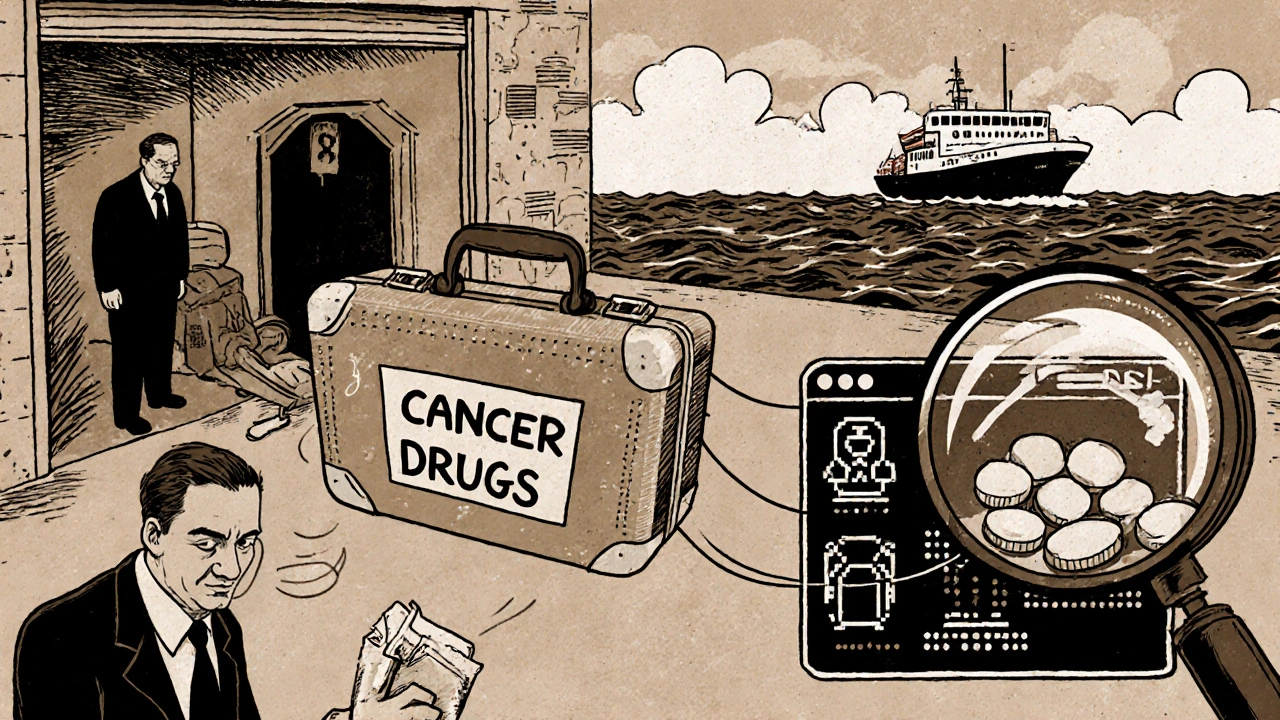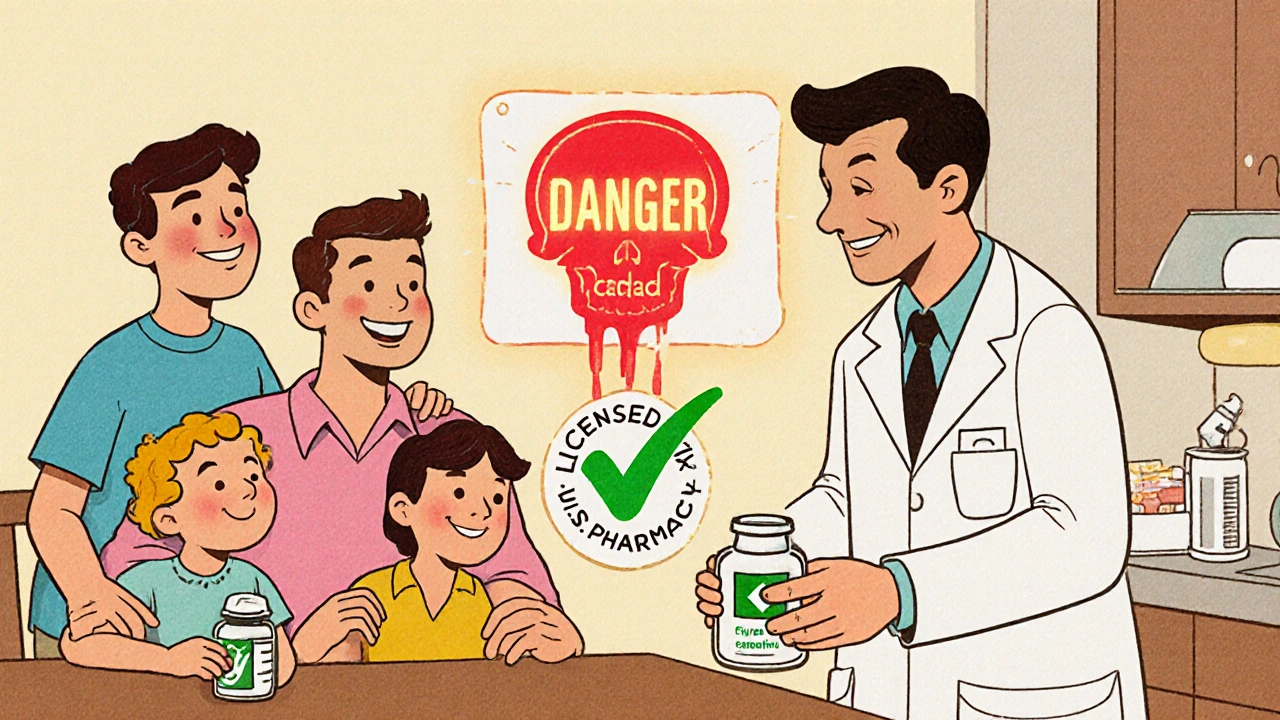International Counterfeit Drugs: Risks When Ordering from Abroad
 Nov, 22 2025
Nov, 22 2025
Every year, millions of people around the world order prescription drugs from websites based in other countries. They do it because the prices are lower. Maybe they don’t have insurance. Maybe their local pharmacy won’t stock the medicine they need. But what they don’t realize is that counterfeit drugs are hiding in plain sight - packaged like the real thing, shipped with fake labels, and sold by sites that look perfectly legitimate.
The truth is simple: if you’re buying medicine from an overseas website that isn’t certified by your country’s health authority, you’re playing Russian roulette with your health. And this isn’t just a theoretical risk. In May 2025, INTERPOL shut down over 13,000 online pharmacies across 90 countries during Operation Pangea XVI. They seized more than 50 million doses of fake pills - including cancer drugs, antibiotics, and erectile dysfunction medications. Some of those pills contained no active ingredient at all. Others had too much - up to 198% of the labeled dose. One man in Australia ended up in the hospital with permanent vision damage after taking what he thought was Viagra. It turned out to be a counterfeit version laced with industrial chemicals.
What Exactly Are Counterfeit Drugs?
Not all fake medicines are the same. The World Health Organization breaks them into two categories: falsified and substandard. Falsified drugs are deliberately and fraudulently mislabeled - they might say they contain sildenafil, but actually contain chalk, rat poison, or floor cleaner. Substandard drugs are made by legitimate manufacturers but fail quality tests - maybe the active ingredient is too weak, or the tablet didn’t dissolve properly. Both are dangerous. Neither is safe.
Counterfeit cancer drugs are especially deadly. These medications have a narrow therapeutic window - meaning even a tiny variation in dosage can kill you. A fake version of a chemotherapy drug might contain only 14% of the needed active ingredient. That means the tumor keeps growing while the patient believes they’re being treated. In 2024, pharmaceutical security reports showed that criminal networks specifically targeted oncology and biologic drugs because they’re expensive, in high demand, and hard for the average person to verify.
Antibiotics are another major concern. If a fake antibiotic contains too little of the active ingredient, it won’t kill the bacteria - but it will teach them how to survive. That’s how drug-resistant superbugs spread. The OECD estimates that counterfeit antibiotics contribute to over 72,000 child deaths from pneumonia every year.
Where Do These Fake Pills Come From?
Most counterfeit pharmaceuticals are manufactured in unregulated labs, often in Southeast Asia - places like China, India, and Bangladesh. These facilities don’t follow any safety rules. No sterile environment. No quality checks. No trained chemists. Just workers mixing powders in basements or garages, then packaging them in boxes that look identical to the real thing.
From there, the drugs move through a global smuggling network. They’re shipped in small packages disguised as “personal use” orders to avoid customs scrutiny. Once they cross borders, they’re distributed through dark web marketplaces, social media ads, and fake pharmacy websites that mimic real ones - complete with professional logos, fake “verified” badges, and even customer testimonials.
Some of these sites even use Google Ads to appear at the top of search results. You type in “buy metformin online cheap” and the first result looks like a legitimate Canadian pharmacy. But it’s not. It’s a front run by a criminal group in Eastern Europe. The site has a physical address - but it’s a vacant warehouse. It has a phone number - but it’s a VoIP line that rings into a call center overseas.
Why Do People Still Buy From These Sites?
Price is the biggest driver. A 30-day supply of insulin that costs $400 in the U.S. might be listed for $80 on a website based in Mexico. For someone without insurance, that’s a life-or-death decision. But here’s the catch: even if the drug is real, importing it without a prescription is illegal in most countries. And if it’s fake? You’ve lost your money, your health, and possibly your life.
A 2024 Kaiser Family Foundation survey found that 18% of Americans have ordered prescription drugs from overseas. But 72% of them didn’t check if the pharmacy was legitimate. Why? Because they didn’t know how.
It’s easy to be fooled. Fake pharmacies copy the exact layout of real ones. They use the same fonts, colors, and even stock photos of doctors. They display fake certifications - “Verified by the FDA” - even though the FDA doesn’t certify foreign pharmacies. They offer “free consultations” with a “licensed pharmacist” - who is often just a chatbot trained to say the right things.

How to Spot a Fake Online Pharmacy
If you’re considering ordering from an international pharmacy, here’s what you need to check - and it’s not just one thing. You need all of these:
- Requires a valid prescription - Legitimate pharmacies never sell prescription drugs without one. If the site lets you buy Viagra or insulin with a quick questionnaire, walk away.
- Has a physical address and phone number - Hover over the address. Does it show up on Google Maps? Call the number. Is it answered by a real person? Or a robotic voice?
- Has a licensed pharmacist available - You should be able to speak directly to a pharmacist, not just a chatbot. Ask them to verify the drug’s manufacturer and batch number.
- Is certified by a trusted program - In the U.S., look for VIPPS (Verified Internet Pharmacy Practice Sites). In Canada, check for CIPA (Canadian International Pharmacy Association). In Australia, the TGA lists approved overseas suppliers. If the site doesn’t display these logos clearly, it’s not trustworthy.
- Uses https:// and has a valid security certificate - This doesn’t mean it’s safe - fake sites use encryption too - but it’s a basic requirement. If the site doesn’t have it, don’t even type your credit card number.
And here’s a hard truth: even if you check all these boxes, you’re still at risk. Criminals are getting better. They now create fake certification badges that look identical to the real ones. The only foolproof way to avoid fake drugs is to buy from a pharmacy licensed in your own country.
The Real Cost of Fake Medicines
It’s not just about getting sick. Fake drugs cause long-term damage to public health systems. When people take counterfeit antibiotics, they don’t recover - and they spread resistant strains. Hospitals see more treatment failures. Doctors have to prescribe stronger, more expensive drugs. Insurance costs go up. Everyone pays.
And then there’s the human cost. A Reddit user in 2025 posted about ordering modafinil from a “Swiss pharmacy.” The pills looked right. The packaging was perfect. But after two days, they started having seizures. The lab analysis later found the pills contained a banned stimulant used in industrial cleaners. Another person ordered diabetes medication from a “UK-based” site. The pills didn’t lower their blood sugar. They didn’t know until they ended up in the ER with diabetic ketoacidosis.
These stories aren’t rare. Trustpilot reviews for unverified international pharmacies average just 2.1 out of 5 stars. The most common complaints? “Pills looked different.” “Didn’t work at all.” “Made me sick.”

What You Can Do Instead
If you’re struggling with the cost of medication, there are safer options:
- Ask your doctor about generic versions - they’re just as effective, often 80% cheaper.
- Use prescription savings cards like GoodRx or SingleCare - they work at local pharmacies.
- Check if your drug manufacturer offers patient assistance programs - many give free or discounted meds to low-income patients.
- For Canadians or Australians: some licensed international pharmacies (like those certified by CIPA or TGA) are safe - but only if you verify them directly through your national health authority’s website.
And if you’ve already ordered from a suspicious site? Don’t take the pills. Save the packaging and contact your local health agency. In New Zealand, report it to Medsafe. In the U.S., go to fda.gov/safety/report-a-problem. In Australia, use the TGA’s reporting portal. These agencies track fake drugs - and your report could help stop the next victim.
Final Warning
There’s no such thing as a “safe” unregulated online pharmacy. Every time you buy from one, you’re funding organized crime. You’re helping criminals make up to 9,000% profit on a pill that could kill you. And you’re making it harder for people who actually need these medicines to get them - because when fake drugs flood the market, regulators crack down on everyone, including legitimate ones.
The next time you’re tempted by a deal that seems too good to be true - remember: your health isn’t a bargain. It’s not a commodity. It’s not something you can risk on a website with a pretty logo and a 4.8-star rating from fake reviews.
Buy your medicine from a licensed pharmacy - in your country. It’s the only way to be sure you’re getting what you paid for.
Can I trust international pharmacies that claim to be certified?
Only if you verify the certification yourself through your country’s official health regulator. Many fake pharmacies display fake badges like “Verified by the FDA” or “CIPA Certified” - but the FDA doesn’t certify foreign pharmacies, and CIPA’s list is publicly available. Always check the official website of the certifying body to confirm the pharmacy is on their list. If the site won’t let you click through to the real certification page, it’s a scam.
Are all drugs from other countries fake?
No. Many countries, like Canada, the UK, and Australia, have strict pharmaceutical regulations and produce high-quality medications. But the problem isn’t the country - it’s the seller. A drug made in Canada is safe if it’s dispensed by a licensed Canadian pharmacy. But if the same drug is sold by a website based in Russia that claims to be “Canadian,” it’s likely counterfeit. Always check the pharmacy’s license, not just where the drug was made.
What should I do if I already took a fake pill?
Stop taking the medication immediately. Contact your doctor or go to an emergency room if you feel unwell. Save the packaging, bottle, and any receipts - these help health agencies track the source. Report the incident to your national drug safety authority. In the U.S., use fda.gov/safety/report-a-problem. In New Zealand, go to medsafe.govt.nz. Your report helps protect others.
Why are counterfeit drugs so hard to detect?
Counterfeiters spend years studying real packaging. They replicate labels, holograms, batch numbers, and even the smell and texture of pills. Many fake drugs are made in the same factories as real ones - just without oversight. Even pharmacists can’t tell the difference without lab testing. That’s why relying on visual inspection alone is dangerous. The only reliable method is buying from licensed sources.
Is it legal to import medication from abroad?
In most countries, it’s illegal to import prescription drugs without a valid prescription and approval from the national health authority. The U.S. FDA, for example, allows personal importation only under very limited conditions - like for a 3-month supply of a drug not available locally, and only if it’s for a serious condition. Even then, it’s not guaranteed to be safe. Customs may seize the package, and you could face fines. The risks far outweigh any savings.
How do I know if a pharmacy is truly licensed?
Go to your country’s official health regulator website. In the U.S., use the NABP’s VIPPS directory. In Canada, check the CIPA list. In Australia, use the TGA’s approved suppliers list. Never trust a pharmacy’s own claims. Always verify through the government source. If the pharmacy isn’t listed, it’s not licensed - no matter how professional it looks.
